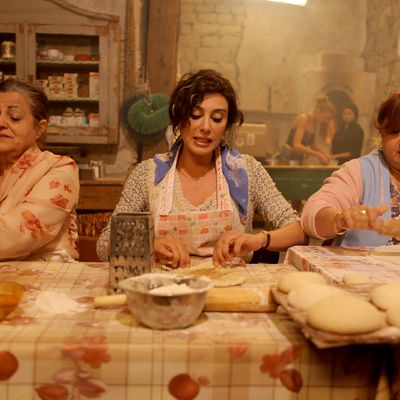
Not to conflate filmmaking style with geopolitical tragedies, but there’s something about the wild tonal shifts of Nadine Labaki’s Where Do We Go Now that seems to mirror the inherent absurdity of the civil war in Lebanon. Of course, all sectarian battles are absurd to some extent, but the Lebanese one, which pits the country’s historically peaceful Muslim and Christian citizens against one another under the influence of regional powers like Syria, was a uniquely surreal phenomenon. The film is a multi-character study in a remote, religiously mixed village where news of fighting between Christians and Muslims comes in ever so slowly and awkwardly, via rickety radio and TV antennae. But it doesn’t need to be a news report that prompts the men to start fighting among themselves. Sometimes, it’s just a gust of wind that results in an accidentally broken cross in the church or a herd of goats pooping in the mosque.
In other words, the unseen outside world — that beyond the borders of the village — is a kind of murderous phantom, not unlike God’s scythe in Camus’s The Plague. We sense it early on, when one villager’s goat loses a leg thanks to a mine and has to be roasted. We sense it more dramatically later on, when another villager is killed after going off in the wrong direction. All of this happens offscreen — what’s onscreen is the way this outside pressure threatens to corrode our characters’ souls.
Labaki’s world is actually not divided between Muslim and Christian, but between male and female. (“Forgive them, for they know not what they do,” says the town priest to the town imam at one point. The imam replies, “You think we do?”) Worried that their men are slipping toward full-out religious war, the women decide to take matters into their own hands, sabotaging the TV and eventually hiring a group of Russian prostitutes to come to the village (under the guise of a broken bus) and keep the men distracted. It is perhaps a sign of Where Do We Go Now’s constantly shifting nature that the quirky Russian prostitute incident is paired with one of the film’s more poignant passages, about a mother who hides her dead son’s body in an attempt to keep her other son from losing his mind.
The story isn’t original, but Labaki’s approach, which seems to pit genres against one another the way it pits genders, is. She uses divergent cinematic styles to demarcate the battle lines. Whenever the men are onscreen, we get mob rule, incendiary shouting matches, violence; when the women are on, however, the film often drifts toward the comedic and even breaks out into song. (There are several surprisingly lovely musical numbers, believe it or not.) As a result, although the film’s why-can’t-we-all-get-along story line and even some of its quirk-laden pit stops feel familiar, the very texture of what we’re seeing seems to change from one moment to the next, resulting in an occasionally breathtaking uncertainty. It’s very hard to feel like you know what’s coming when you can’t even tell what movie you’re in.


